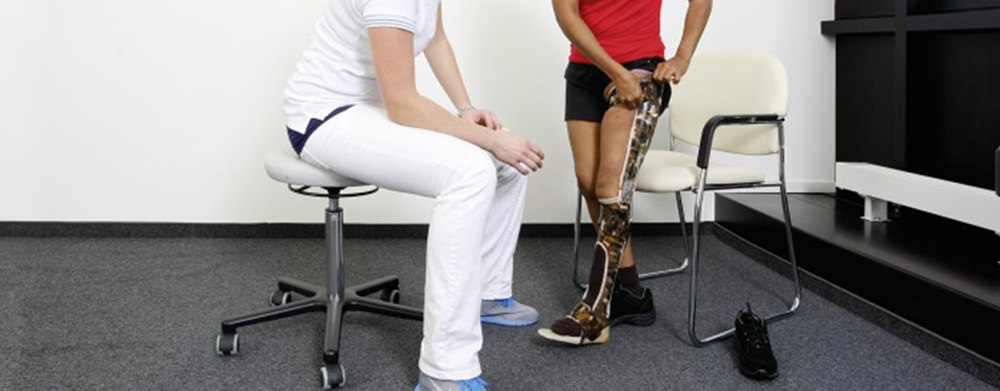

Wear in Schedule
It is necessary to follow a gradual increase in wear to build up your skin and soft tissue tolerance to the brace. Unless otherwise instructed, begin by wearing the brace one to two hours your first day. Add one hour per day as tolerated until you are comfortable wearing the brace full time and do not experience any red marks or pressure sores on the skin.
The brace ordered by your provider is designed to help support your knee, ankle, and foot. It is to be worn during waking hours or for all weight-bearing activities.
Clothing
Your KAFO should always be worn with a sock and shoe. The sock should be long enough so you have no exposed skin in contact with the brace. This will help prevent rubbing as well as absorb perspiration. Low-healed, lace-up shoes, such as walking shoes or sneakers, are ideal. The shoe should fit snugly with the orthosis, not allowing the foot to slip inside of it. Never walk on the brace without a shoe on. This may cause you to slip and fall or break the brace.
Skin Care
Check your skin after every wear period for any new signs of redness or irritation. This is especially important if you are diabetic or have a lack of protective sensation in your legs. Your brace should fit snugly but not cause any pain, bruises, or blisters. Some amount of pinkness is expected in areas of maximum correction or support. Any redness should disappear within 15 minutes of removing the brace. If you feel pain, or if redness on your skin lasts more than 15 minutes, call the office to schedule a follow-up appointment to have the brace adjusted.
It is important to keep your skin clean to avoid irritations. Mild soap and water are recommended. Do not use lotions, oils, or ointments under your brace. If needed, use sparingly and allow to dry before putting the brace on.
Care of your Brace
- Frequent cleansing is important. Your brace can be cleaned with a washcloth and mild, soapy water. If your brace has removable pads, they should be hand-washed with mild detergent, rinsed thoroughly, and air-dried. Saddle soap can be used on leather portions. Make certain all soap residue is removed and the brace is completely dry before reapplying.
- A hair dryer on cool setting can be used to help dry the brace.
- Wash and rinse thoroughly if exposed to salt water.
- Do not expose your brace to extreme temperatures (such as a closed car on a hot, sunny day).
- If the hinges start to squeak, feel free to apply some dry lubricant such as Brace Eze, Teflon, silicone spray, or PAM.
- Occasionally check for signs of wear. If you think repairs are needed, call for an appointment.
When to Call for an appointment
You should see a bracing specialist for a follow-up appointment within a few weeks of receiving your brace. Please call if you notice the following:
- You have developed red areas or pressure sores from your brace
- You have had a significant weight change and your brace is too loose or too snug
- You are experiencing new pain in other areas of your body (knees, hips, or back)
- The straps or Velcro no longer hold tight, or other material is worn
- You have any questions or concerns
Never attempt to adjust or repair the inserts yourself.
If you have questions, you are always welcome to reach out to us and we are ready to assist.
(651) 968 -5700
